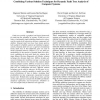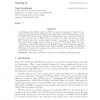785 search results - page 73 / 157 » Binary Join Trees |
105
click to vote
ATVA
2007
Springer
15 years 4 months ago
2007
Springer
Fault tree analysis is a traditional and well-established technique for analyzing system design and robustness. Its purpose is to identify sets of basic events, called cut sets, wh...
100
click to vote
HASE
1998
IEEE
15 years 2 months ago
1998
IEEE
Fault trees provide a graphical and logical framework for analyzing the reliability of systems. A fault tree provides a conceptually simple modeling framework to represent the sys...
FSTTCS
2005
Springer
15 years 3 months ago
2005
Springer
Monitoring a distributed system to detect a stable property is an important problem with many applications. The problem is especially challenging for a dynamic distributed system b...
SSDBM
2003
IEEE
15 years 3 months ago
2003
IEEE
Relational index structures, as for instance the Relational Interval Tree, the Relational R-Tree, or the Linear Quadtree, support efficient processing of queries on top of existin...
MCS
2005
Springer
15 years 3 months ago
2005
Springer
A Half-Against-Half (HAH) multi-class SVM is proposed in this paper. Unlike the commonly used One-Against-All (OVA) and One-Against-One (OVO) implementation methods, HAH is built ...


